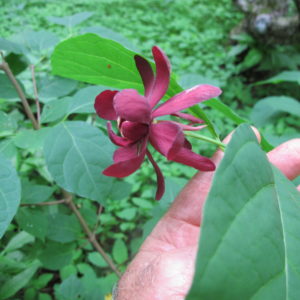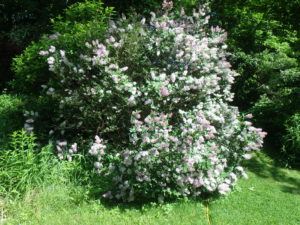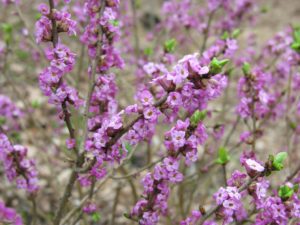A Dozen Sweet-Smelling Shrubs
Lilac season is about over. For the lasts two weeks I have been enjoying the amazing fragrance of ‘Miss Kim’, a species lilac (Syringa patula) with light purple blossoms. It was sold to me some 25 years ago as a dwarf lilac, but it is not. It’s just slow-growing. Mine is now 10 feet tall and wide. It was loaded with many hundreds of blossoms, and I was able to smell its fragrance from across the garden.
I have a gardening friend, Nelia Sargent of Claremont, NH, who specializes in fragrant plants. She is blind, so she cannot see their blossoms; she grows them, in part, because she loves their scent.
I called Nelia and asked for her list of fragrant shrubs. She told me that her goal is to have fragrance in her house and garden from spring until fall. “And I don’t want to have to put my nose in the flowers,” she said. “I want to smell them from 5 or 10 feet away, or even further.”
So she and I put together a list, roughly in sequence of bloom times. We agreed that even a shrub that should be fragrant, isn’t always sweet-smelling. So we recommend buying for fragrance when the plant is in bloom.
The earliest on Nelia’s list is a spring-blooming witchhazel (Hamamalis vernalis), one called ‘Arnold’s Promise’. It is hardy to Zone 4, but I have never grown it, but will. She has it and says it blooms in late winter. The frilly yellow blossoms are infused with red, and it is highly fragrant. She cuts blossoms and brings them in the house when snow is still on the ground, and they last in a vase for up to 2 weeks.
Next comes February daphne (Daphne mezereum). I’ve had this for over 15 years, and like it so much I named my little corgi after it. It has nice sweet pink blossoms that bloom in April. Mine rarely needs pruning and is still not 5 feet tall and wide. Mine was winter damaged this year for the first time ever. I like to cut stems in March and bring them in to bloom indoors.
Then come the Viburnums. Many are fragrant, some very fragrant. Three that Nelia likes are Viburnum judii, V. carlessii, and V. burkwoodii. Many viburnums are susceptible to the viburnum leaf beetle, which can defoliate a shrub in a week or less. Nelia told me she has not had a problem with those three. Birds love the berries viburnums produce.
A nice fragrant understory shrub that I grew up with in Connecticut is spicebush (Lindera benzoin). Its flowers are negligible, but its leaves are fragrant. I learned this as a boy, pulling off a leaf and noticing the strong scent. As a teenager I chewed on the twigs, using them as a breath freshener! I was able to find one for sale and have been growing it in dry shade for 3 years now.
Nelia mentioned fothergilla (Fothergilla major) as a fragrant shrub with a pleasing subtle scent. I’ve grown it for 20 years or so, and love it for the white, bottlebrush flowers in May and fabulous fall leaf color; but I have never noticed the fragrance. Mine might be the exception, and once again proves it important to buy things in bloom if you want fragrance.
All lilacs have nice fragrance in bloom, I think. Nelia was once asked to judge their scent for the Arnold Arboretum at Harvard. She determined that there are at least 20 different lilac fragrances in their collection. If you select early, mid-season and late-blooming lilacs, you can have 5 weeks of fragrance and blossoms, she said.
Nelia Sargent noted that the Japanese tree lilac (Syringa reticulata) is very fragrant, but that it should probably be considered an invasive and not planted. Seeds are spread by birds, and this stranger from a foreign land can out-compete many of our native understory plants. The gardeners at Saint Gaudens National Park have observed this, and actively remove them whenever they see them.
 Carolina allspice or common sweetshrub (Calycanthus floridus) has been blooming for me since mid-June and has lovely deep wine-red flowers; it prefers a shady spot with rich moist soil. Although Nelia considers it fragrant, mine is not, or just barely. Still, a shrub that blooms in shade is always welcome in my gardens.
Carolina allspice or common sweetshrub (Calycanthus floridus) has been blooming for me since mid-June and has lovely deep wine-red flowers; it prefers a shady spot with rich moist soil. Although Nelia considers it fragrant, mine is not, or just barely. Still, a shrub that blooms in shade is always welcome in my gardens.
In August there is summersweet clethra (Clethra alnifolia). Nelia says a pink variety called ‘Ruby Spice’ is very fragrant. I have the wild white one, and it is fragrant, but not very.
In late August or early September the seven-son flower tree (Heptacodium miconioides) tree blooms. It is a very fast-growing tree – branches can grow 5 to 7 feet in a single season, but it slows down some when it reaches its full size of 25 feet tall or so. Mine has a pleasant, but not overpowering scent.It has wonderful exfoliating bark that is splendid in winter.
This list of fragrant shrubs cannot include them all. Mock orange, for one, is very strong smelling. Some rhododendrons are fragrant, particularly the native swamp azalea (Rhododendron viscosum). Please write me if you have a favorite I have neglected to mention. Perhaps I need to grow it!
Write Henry at henry.homeyer@comcast.net or P.O. Box 364, Cornish Flat, NH 03746. Please include a SASE if you wish a response by snail mail. Henry is the author of 4 gardening books.




